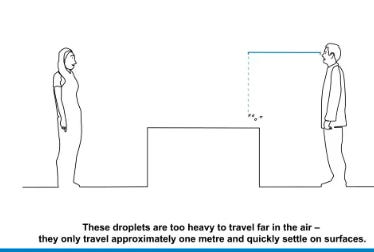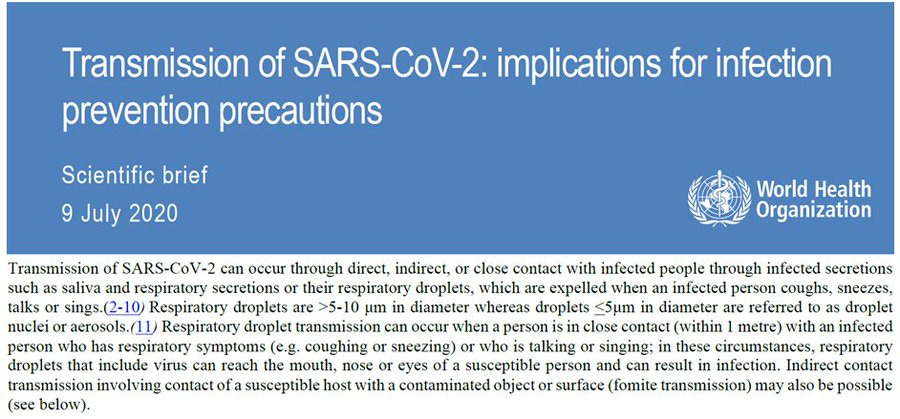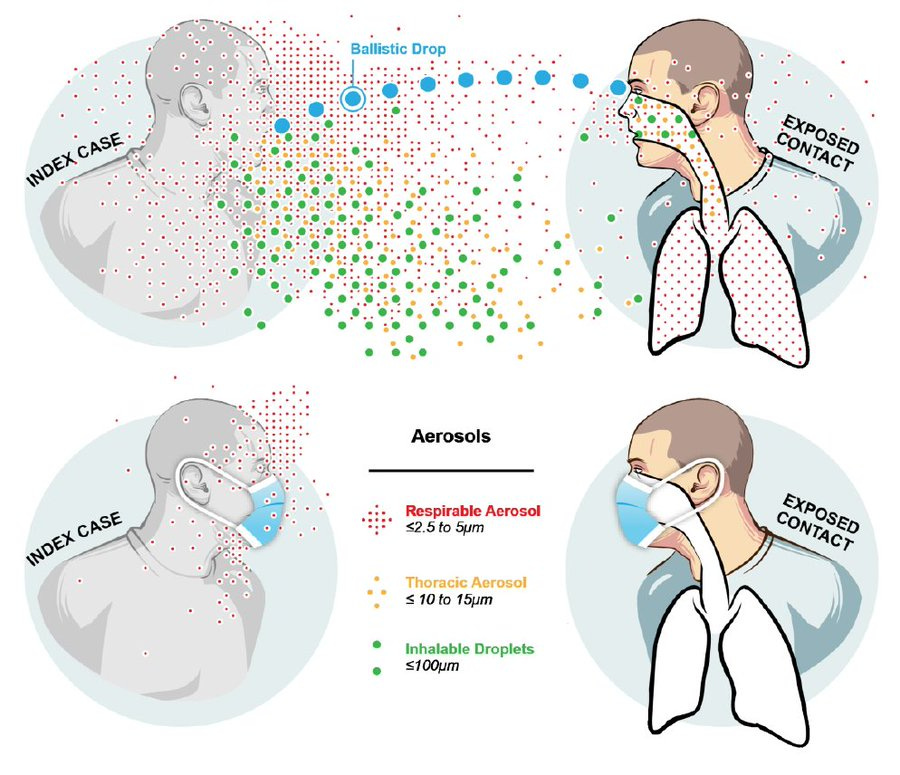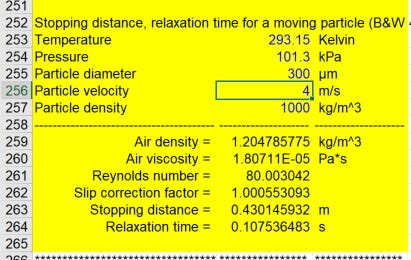To view keyboard shortcuts, press question markView keyboard shortcuts
Thread
Originally posted on Twitter. Transcribed here for ease of reading and just in case something happens to Twitter.
Also available as Thread Unroll at https://threadreaderapp.com/thread/1292880342227984385.html
1/ Aerosols, droplets, & “flexible droplets” Trying to clarify key aspects. Details complex, give bottom lines 1st: Bottom line 1: If fall within 1-2 m of the person (WHO or CDC droplets), then **have to** infect by ballistic impact (“angry birds”). Cannot infect by inhalation
2/ Bottom line 2: If they can be inhaled, they can travel farther than 1-2 m. They are less infective farther away due to much greater dilution (like smoke). These are *aerosols.* There is a clear and distinct physical boundary between droplets and aerosols at ~ 100 um
3/ Bottom line 3: for efficient ballistic impact on conversation partner, droplets need to travel horizontally ~0.5-1 m (3-6 ft). For this, they need enough momentum to overcome air drag. Actually need to be > 300 um. Otherwise, friction of the air stops them along the way.
Bottom line 4: When talking, there are very few particles 300 um and larger, which are visible with the naked eye (a human hair is 80 um). And those very few particles have to hit very small targets: eyes, nostrils, mouth.
Bottom line 5: Aerosols stay in the air minutes to hours indoors, finely divided, many chances for inhalation. For this combination of reasons, physics greatly favors aerosols and greatly disfavors droplets for infection under close proximity. When talking, it is aerosols!
6/ Wrote this thread based on many discussions w/ ppl in epid. & related fields. Sometimes hear what I call “flexible droplets”. Follow WHO / CDC definitions most of the time, but have flexible aerosol-like properties when needed (e.g. to explain an outbreak). Do they exist?
7/ On to the details, fasten your seatbelts! We need to review **Vertical Motion** first, and then **Horizontal Motion**. These can be treated as decoupled (can be studied separately) to first approximation per Newton’s law in vector form.
8/ All physics we need are Newton’s law, law of gravity, Stokes’ drag law, and measurements of typical conditions when talking. Nothing very difficult or uncertain. But unfamiliar to many, motion of small objects we don’t see does not follow intuition from larger objects we see.
9/ PART 1: VERTICAL MOTION. Droplets are being defined e.g. by WHO as those particles that fall quickly to the ground, within 1-2 m. See eg WHO cartoon and video:

Watch this short animation to learn more about #COVID19, how it spreads and how to protect yourself against it. #coronavirus
10/ See below for formal definition of droplets in the latest WHO scientific briefing: https://who.int/publications/i/item/modes-of-transmission-of-virus-causing-covid-19-implications-for-ipc-precaution-recommendations…
11/ CDC has used a similar definition for decades, see this discussion from Xie et al (Yuguo Li’s group, leading on disease transmission, just invited to talk in large WHO webinar last week) So droplets defined as angry birds indeed, and they fall within 1-2 m of person.
12/ Will explore vertical motion by doing simple calculations. I will use CDC’s own and very respected aerosol calculator program (Paul Baron, CDC employee who wrote "Aerosol Measurements" = bible of aerosols). Calculator can be downloaded from here:

Introduction to aerosols and basic calculations - Intro to aerosols from Paul Baron, NIOSH, CDC: http://cdc.gov/niosh/topics/aerosols/pdfs/Aerosol_101.pdf… - Aerosol calculator from Paul Baron: http://cires1.colorado.edu/jimenez/COVID/Aerosol_Calc_Settling_Stopping.xls… In particular calcs for settling velocity and stopping distance in rows 199-279
Show this thread
13/ Typical indoor air speed is 0.1 m/s. So a droplet needs to fall within 10-20 seconds to fall within 1-2 m. (All calculations are approximate here to make the point, there are more detailed studies such as
Short-range airborne route dominates exposure of respiratory infection during close contact
14/ Here we will consider that the particles have equilibrated with the ambient humidity, which happens (faster than falling) for particles smaller than 100 microns, see and the Wells curve (https://onlinelibrary.wiley.com/doi/10.1111/j.1600-0668.2007.00469.x…). The sizes we will discuss are *after* evaporation.
15/ Addressing 3 misconceptions in passing: - "Virus is 0.1 um", naked in the air. Not it is not. - “Water uptake by virus-containing particles makes them heavier and they fall out of the air faster.” This effect is small, unless the relative humidity is > 85%
16/ Misconception 3: - “Drying kills the virus”: the opposite is true for SARS-CoV-2 and other viruses, drying helps survival (https://dhs.gov/science-and-technology/sars-airborne-calculator…)
17/S
17/So let's calculate which particle sizes have the CDC / WHO “droplet” behavior and fall in 1-2 m. Under typical conditions, a 50 um particle falls within 2 m. (Aerosol calculator above, cell A235. File --> options --> enable iteration --> 100)
18/ A 100 um particle falls within 0.6 m.
19/ These calculations are approximate, but consistent with more detailed studies, where the boundary of “droplet” behavior was found to range 60-125 um, depending on ambient humidity (https://onlinelibrary.wiley.com/doi/10.1111/j.1600-0668.2007.00469.x…).
20/ Now clear how wrong 5-10 um boundary btw aerosols and droplets is. A 50 um particle has 1000 times the mass of a 5 micron particle (a cat to an elephant). 100 um has 8000 times the mass of 5 um particle. Not a small error!
21/ And gravity on Earth would need to be ~100 times larger (as in some starts) for 5 um particles to fall within 2 m (just use the aerosol calculator and change the acceleration of gravity in the formula on cell B209 from default value of 9.807 m/s2 to 950 m/s2
22/ Yes the 5 um is everywhere in the infectious disease literature, and has been for decades. And… it is totally wrong! And, it suggests that ppl writing those guidelines and lots of papers quoting the 5 um for decades were perhaps not familiar with these basic aerosol...
23/ calculations, known since the 19th century at least, and the CDC aerosol calculator (available since at least 1998), and never bothered to check?
24/ Can we trust people who kept quoting the 5 um droplet cuttoff, when they interpret other aspects of aerosol behavior in very complex situations (hospitals, community, PPE) correctly, by themselves? Perhaps consulting aerosol and indoor air experts would seem useful?
25/ We are working with historians to understand how the “5 um error falls within 1-2m” error came about, and we think we’ve figured out, but that’s a story for another day:


We're rehashing the same arguments from 100 years ago. Hopefully we'll learn this time around. Collaborating with historians @EThomasEwing Katie Randall and Lydia Bourouiba @jljcolorado to look at history on airborne transmission and why we haven't made much progress in 100 yrs. twitter.com/EThomasEwing/s…
26/ From here on we will use the result of Xie et al. from Yuguo Li's group (https://onlinelibrary.wiley.com/doi/10.1111/j.1600-0668.2007.00469.x…) that droplet behavior at 50% RH, typical of many locations, starts at > 100 um.
How far droplets can move in indoor environments – revisiting the Wells evaporation–falling curve
Click on the article title to read more.
27/ Now, it is well-known that only particles smaller than ~100 um can be inhaled. Larger particles cannot. This again can be explored with other parts of the aerosol calculator. See for example this recent article by @Don_Milton: https://academic.oup.com/jpids/article/doi/10.1093/jpids/piaa079/5875939?guestAccessKey=72cf62f5-ae56-4073-a264-7b3818371f07…
28/ So finally we get to the bottom line for vertical motion. If they fall within 1-2 m, they are 100 um or larger and both: (a) **have to** infect by ballistic impact AND (b) they *cannot* be inhaled. Repeat: large droplets that fall close to the person cannot be inhaled
29/ To be inhalable, they need to be < 100 um. If they are < 100 um, basic physics tells us that they can travel around the room. Are aerosols. From CDC’s own “Aerosols 101” tutorial (

), see that 10 um particles stay aloft 8 min, and 3 um particles 1.5 h.
Introduction to aerosols and basic calculations - Intro to aerosols from Paul Baron, NIOSH, CDC: http://cdc.gov/niosh/topics/aerosols/pdfs/Aerosol_101.pdf… - Aerosol calculator from Paul Baron: http://cires1.colorado.edu/jimenez/COVID/Aerosol_Calc_Settling_Stopping.xls… In particular calcs for settling velocity and stopping distance in rows 199-279

30/ These aerosols infect at the room scale: restaurant, call center, choir, buses, + many superspreading events ”singing at karaoke parties, cheering at clubs, having conversations in bars, and exercising in gymnasiums” (https://wwwnc.cdc.gov/eid/article/26/9/20-2272_article…). Hard to explain w/o aerosols
31/ And if they can infect at the room scale by inhalation under low ventilation, they can infect at close proximity by inhalation. And they will do so **much much more easily** than at the room scale, because they are so much more concentrated in close proximity (like smoke).
32/ Next Bottom line for vertical motion: “flexible droplets” do not exist. Droplets that fall within 1-2 m cannot infect by inhalation, they have to infect ballistically, “like angry birds”
33/ PART 2: HORIZONTAL MOTION. First the simple part, already discussed: aerosols stay in the air, will be carried by air motions of 0.1 m/s. So can easily travel across the scale of a room.
34/ Next droplets. Have to infect by ballistic impact. Once they leave the mouth at ~ 4 m/s when talking (https://sciencedirect.com/science/article/abs/pii/S0360132320302183…) they experience drag from air.
Short-range airborne route dominates exposure of respiratory infection during close contact
35/ Let’s use the calculation of stopping time in the aerosol calculator (Cell A252). This is more approximate due to not including the effect of the “jet”, but we will look at rigorous research results later.
36/ Calculate stopping distance for 100 um due to drag from air with CDC aerosol calculator. We get ~ 0.07 m (3 inches). So those droplets are going to have a hard time reaching person that we are talking to, as conversational distance in US is 0.5-1 m (https://iris.xyz/growth/personal-space-how-to-find-the-right-distance/…)
37/ To really reach someone 0.5 m away, particles need to be >=300 um, almost 4 times the diameter of a human hair, and clearly visible. How many of those do you see when talking to others, coming towards you and landing on your eyes etc? It happens, but it is not very common.
38/ NEXT: how many >300 um droplets per measurements? Exist, but uncommon (talking). Graph recent measurements (https://sciencedirect.com/science/article/pii/S0021850211001200#f0015…). Note logarithmic Y scale. Aerosols far more numerous, floating, finely dispersed, much easier to inhale. Efficient droplets few & far between
39/ It is often said that that droplets have far more volume than aerosols. Graph above (+ convertto vol., integrating) shows that volume of efficient droplets (talking) is comparable to that of aerosols. And infrequent droplets have to hit very small targets, such as the eyes.
40/ Physics has unfairly stacked many disadvantages against droplets! No wonder that, as stated by Yuguo Li (leader on disease transmission, invited to speak to WHO), droplets have never been demonstrated *directly* to transmit ANY disease in the history of medicine.
41/ And there is no evidence at all that I am aware of to strongly support the WHO / CDC determination that droplets are a major way of transmission for SARS-CoV-2 (https://docs.google.com/presentation/d/11rY9tQtkFaV_M4N-hf5qp1_Xtuw8JYb4Qvv5e7BEmcc/edit#slide=id.p…)
42/ Note that ballistic droplets of 300-1000 um will not be easily displaced by light winds outdoors (again we could use the aerosol calculator to estimate this. But I trust the thread is long enough by now!). But fine aerosols, like smoke, will be dispersed much more easily...
43/ providing easy explanation about why outdoors transmission is so much less than indoors. Not heard any credible hypotheses to explain that key observation with droplets. (UV deactivates the virus, but too slowly to matter in close proximity, see https://dhs.gov/science-and-technology/sars-airborne-calculator…)
44/ Bottom line: physics greatly favors aerosol transmission and disfavors droplet transmission. Aerosols are major for SARS-CoV-2, droplets probably only significant for coughing and sneezing.
45/ The sooner this is accepted, the sooner we can get to work to make control policies smarter. Move activities outdoors, better explain masks, pay attention to tight fit of masks, increase ventilation & filtration (HVAC, portable HEPA, or makeshift fan-filter) indoors and so on
47/ Thanks if you made it to here. If I got something wrong, pls comment (if I don’t reply, email me, sometimes I can’t read all the twitter comments). I would particularly appreciate any studies that have looked at physics, and concluded droplets matter. Haven't found any.
48/ PS: forgot to include, figure from a more detailed study (https://aip.scitation.org/doi/10.1063/5.0021427…) reaching conclusions similar to Tweets 37-38. Droplets need to be >300 um to reach across 1 m efficiently. Consistent with https://sciencedirect.com/science/article/abs/pii/S0360132320302183…




























